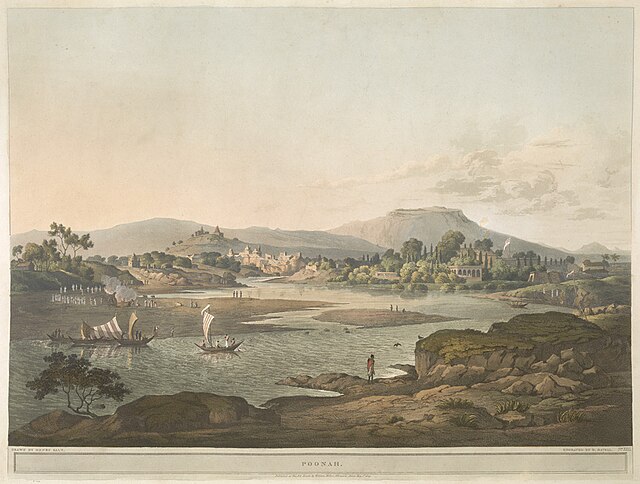The Marathi people or Marathis are an Indo-Aryan ethnolinguistic group who are native to Maharashtra in western India. They natively speak Marathi, an Indo-Aryan language. Maharashtra was formed as a Marathi-speaking state of India on May 1, 1960, as part of a nationwide linguistic reorganisation of the Indian states. The term "Maratha" is generally used by historians to refer to all Marathi-speaking peoples, irrespective of their caste; However, it may refer to a Maharashtrian caste known as the Maratha.
Territory under Maratha control in 1760 (yellow), with its vassals
A watercolor painting of Pune from the late Peshwa era as seen from the confluence of the Mula and Mutha rivers, by British artist Henry Salt. The picture clearly shows the permanent features of the place and cremations. River confluences have been popular in Hinduism for cremations and also for ceremonial disposal of ashes
B. R. Ambedkar, a polymath and Social reformer
Sayajirao Gaekwad III, the Maratha Maharaja of Baroda
Marathi is an Indo-Aryan language predominantly spoken by Marathi people in the Indian state of Maharashtra. It is the official language of Maharashtra, and an additional official language in the state of Goa used to reply provided the request is received in Marathi. It is one of the 22 scheduled languages of India, with 83 million speakers as of 2011. Marathi ranks 13th in the list of languages with most native speakers in the world. Marathi has the third largest number of native speakers in India, after Hindi and Bengali. The language has some of the oldest literature of all modern Indian languages. The major dialects of Marathi are Standard Marathi and the Varhadi dialect.
981 A.D. Prakrit inscription at the foot of Bahubali statue at Jain temple in Shravanabelagola It was derived from Prakrit language
Marathi inscription inside Brihadisvara temple complex, Thanjavur
The popular Marathi language newspapers at a newsstand in Mumbai, 2006
Poster showcasing comparison of Marathi language speakers with Germany and Netherlands.








